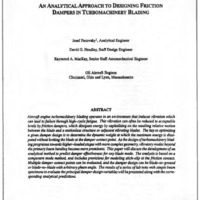-
Title
-
An Analytical Approach To Designing Friction Dampers In Turbomachinery Blading
-
Report Number
-
WL-TR-91-3078 Volume III, p. JBA-1 thru JBA-14
-
Creator
-
Panovsky, Josef
-
Hendley, David O.
-
MacKay, Raymond A.
-
Corporate Author
-
GE Aircraft Engines, Cincinnati, Ohio and Lynn, Massachusetts
-
Date
-
1991
-
Date Issued
-
1991-08
-
Extent
-
14
-
Identifier
-
ADA241313
-
Format
-
1 online resource
-
Abstract
-
Aircraft engine turbomachinery blading operates in an environment that induces vibration which can lead to failure through high-cycle fatigue. This vibration can often be reduced to acceptable levels by friction dampers, which dissipate energy by capitalizing on the resulting relative motion between the blade and a motionless structure or adjacent vibrating blades. The key to optimizing a given damper design is to determine the dynamic weight at which the maximum energy is dissipated without locking the blade at the damper contact point. As the design of turbomachinery blading
progresses towards higher-loaded stages with more complex geometry, vibratory modes beyond the primary beam bending become more prominent. This pape will discuss the development of an analytical method to predict damper effectlveness for any blade mode. The analysis is based on a component mode method, and includes provisions for modeling stick-slip at the friction contact. Multiple damper contact points can be evaluated, and the damper design can be blade-to-ground or blade-to-blade with arbitrary phase angle. The results of a series of lab tests with simple beam specimens to evaluate the principal damper design variables will be presented along with the corresponding analytical predictions.
-
Description
-
Aircraft engine turbomachinery blading operates in an environment that induces vibration which can lead to failure through high-cycle fatigue. This vibration can often be reduced to acceptable levels by friction dampers, which dissipate energy by capitalizing on the resulting relative motion between the blade and a motionless structure or adjacent vibrating blades. The key to optimizing a given damper design is to determine the dynamic weight at which the maximum energy is dissipated without locking the blade at the damper contact point. As the design of turbomachinery blading
progresses towards higher-loaded stages with more complex geometry, vibratory modes beyond the primary beam bending become more prominent. This pape will discuss the development of an analytical method to predict damper effectlveness for any blade mode. The analysis is based on a component mode method, and includes provisions for modeling stick-slip at the friction contact. Multiple damper contact points can be evaluated, and the damper design can be blade-to-ground or blade-to-blade with arbitrary phase angle. The results of a series of lab tests with simple beam specimens to evaluate the principal damper design variables will be presented along with the corresponding analytical predictions.
-
Distribution Classification
-
1
-
Distribution Conflict
-
No
-
DTIC Record Exists
-
No
-
Illinois Tech Related
-
No
-
Photo Quality
-
Not Needed
-
Report Availability
-
Full text available
-
Type
-
article
 articleJBA
articleJBA